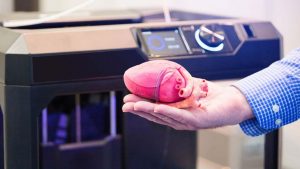We have discussed a lot about materials within bioprinting as well as different printers that are used to work on bioprinting technology. We have not had an in-depth focus on current applications within bioprinting. We have briefly discussed a couple in articles, but will take a look at some interesting applications of bioprinting within the clinical setting.
Bioprinting must be very precise in terms of material preservation and creation. One must take into account that the body is very particular. It operates at specific temperatures and pH levels in order to sustain life. Typically bioprinted objects refer to structures we want to use for the body. For this to work they have to be of the following nature: completely mimicking an object within the body, or being able to morph into an object within the body due to biological reactivity. Both approaches are difficult in their own ways.
It is difficult to mimic certain vascular structures within an organ or tissue. This requires extreme precision. Usually, a technology that helps with this is related to MRI, CT Scans, and other typical imaging software because it allows for ready made 3D objects to be created. However, the problem then lies within how accurate the imaging is on the outside of an object, as well as the inside morphology. Something like a liver, for example, has not just a hollow exterior, but also a complex inner structure.
It is difficult to only have a bioprinted object that relies on bioactivity to take the form of a structure previously in the body. The reason for this lies in needing to be extremely precise with material generation. The precision of a biomaterial and its production forces us to have precise analytical chemistry skills as well as biochemistry knowledge to understand the impact of trying to make a uniform biomaterial with enough bioactivity to evolve into a living organ. The natural fear one would have is the possible rapid development of said object within the body. Hence the fear of cancerous growth is not unfounded. Also, there is a concern that the body may just reject the foreign item that is trying to be used within the body.
Let us take a look into orthopedics. If we are to apply the method of mimicking bone structure within the body here are the problems likely to be faced:
- We are likely to have trouble matching the specific structure that is needed for an individual bone wise.
- We are fearful of the nanostructure of the material and how it may corrode or degenerate over time.
- We are also worried about biochemical reactivity based on the biomaterials we use to print out a piece of orthopedic material and how this may lead to toxicity problems for a patient in the future.
If we are to apply the method of having a material that can morph into a biomaterial such as a bone within the body, here are the ramifications:
- We are worried about over reactivity and cancerous growth.
- We are also worried about under reactivity and needing to have continual surgeries.
- We are also worried about initial rejection of the material by the body.
The way to approach this problem within bioprinting and clinical methods, typically has been focused on combining these two processes of biomimicry and adaptive reactivity. However there are some interesting technologies that are leading to more options within the bioprinting industry as a whole. I will report on these in a couple of articles soon.
Subscribe to Our Email Newsletter
Stay up-to-date on all the latest news from the 3D printing industry and receive information and offers from third party vendors.
You May Also Like
Gorilla Sports GE’s First 3D Printed Titanium Cast
How do you help a gorilla with a broken arm? Sounds like the start of a bad joke a zookeeper might tell, but it’s an actual dilemma recently faced by...
Nylon 3D Printed Parts Made More Functional with Coatings & Colors
Parts 3D printed from polyamide (PA, Nylon) 12 using powder bed fusion (PBF) are a mainstay in the additive manufacturing (AM) industry. While post-finishing processes have improved the porosity of...
$25M to Back Sintavia’s Largest Expansion of Metal 3D Printing Capacity Since 2019
Sintavia, the digital manufacturing company specializing in mission-critical parts for strategic sectors, announced a $25 million investment to increase its production capacity, the largest expansion to its operations since 2019....
Velo3D Initiates Public Offering in a Bid to Strengthen Financial Foundations and Drive Future Growth
Velo3D (NYSE: VLD) has been among a number of publicly traded 3D printing firms that have attempted to weather the current macroeconomic climate. After posting a challenging financial report for 2023,...


































